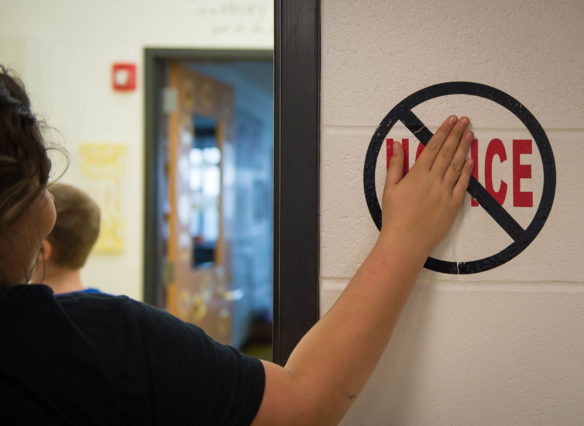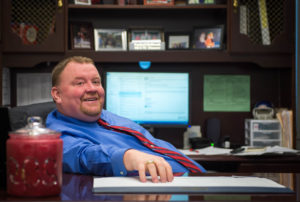
Robertson County School students walk through the “Hall of Success” in between classes. The school has made it a habit to celebrate its students’ success, including having 100 percent of seniors college- and/or career-ready in 2016.
Photo by Bobby Ellis, Dec. 13, 2016
By Brenna R. Kelly
Brenna.kelly@education.ky.gov
The brightly colored halls of Robertson County School were a dark place in February 2015.
The district was ranked last in the state in Kentucky’s school accountability system, teachers and staff had been cut, the superintendent had resigned and, because of falling enrollment, the Kentucky Department of Education (KDE) was pondering whether the district would survive.
Then it snowed.
“It was cold, it was awful,” said Holly Linville, instructional supervisor at the preschool through 12th-grade school.
With students home for a snow day, administrators called in everyone – teachers, custodians, bus drivers and cafeteria workers.
Gathered in the school’s Family Consumer Science room, they watched a clip of a Kentucky Board of Education (KBE) meeting detailing the district’s grim prognosis.
Robertson County’s birth rate was declining and with few new job opportunities, the population – along with school enrollment – would likely continue to fall, then-Associate Commissioner Hiren Desai told the board. The county’s population dropped 6.3 percent from 2010 to 2015, to about 2,100 residents, according U.S. Census estimates.
“They are going to have to consider, quite frankly, whether or not they need to merge with another school district,” Desai told the board.
“That was our wake-up call right there,” said Principal Jamey Johnson
So they got to work.
Less than two years later, the purple, green and orange-tiled halls are a very different place. Pictures of students who have scored Distinguished or Proficient on state assessments line the walls, a banner extols 100 percent college- and career-readiness and, as they walk the corridors, students receive hugs and words of encouragement from Superintendent Sanford Holbrook, who greets them by name.
The district went from an overall score of 46.6 in the 2013-14 Unbridled Learning accountability results to a score of 80 in the 2015-16 results. The elementary school is a School of Distinction and the middle and high are both Distinguished.

A Robertson County School student slaps a “No Novice” sign as he leaves a classroom. The district started the practice as a way to motivate students. Last school year, no students performed at the novice level in 8th-grade social studies or 3rd-grade math.
Photo by Bobby Ellis, Dec. 13, 2016
There was no magic bullet, district and KDE officials say, but rather it was a combination of a new superintendent, a revamped the curriculum, help from KDE Education Recovery staff and teachers who believed in their students that has helped the district improve in such a short time.
Teachers and administrators had been working hard when the KBE placed the district on state assistance in 2013, but they weren’t seeing the results, said Jim Hamm, state assistance monitor for KDE’s Office of Continuous Improvement.
“Robertson County leadership embraced systems of continuous improvement and received the necessary guidance and support they needed,” he said. “Every stakeholder fought to reach the same goal and had a common vision.”
Before the snow day meeting, teachers and staff didn’t realize how bad the situation was, said middle school social studies teacher Aaron Massey, who like most of the school’s teachers grew up in the county.
“Right then and there we all sat down and said, ‘All right, we’ve got pull our sleeves up, we’ve got to dig in, we’ve got to get to work,’” he said.
Two years later, they still follow the plan they created that day – making sure someone greets the students with a smile each morning and calling students by name everywhere from the classrooms to the lunch line.

Sanford Holbrook became superintendent of Robertson County in July 2015, when the district was one of the lowest performing in the state. By the 2015-16 school year, the district had become one of the highest performing in the Commonwealth.
Photo by Bobby Ellis, Dec. 13, 2016
When Holbrook arrived in July 2015, he knew every student and staff members’ names from studying the yearbook.
“He’s been a tremendous motivator,” Johnson said. “I think that’s where we got some of the student buy in.”
Holbrook also called every family who moved their children to another district and asked them to return. Many did and the school now has 369 students, up from 334 two years ago.
This year’s kindergarten class, which was predicted to have nine students, has 34, which led the district to hire another kindergarten teacher, Holbrook said.
The academic work was harder, but the teachers were committed to improving daily instruction, said Nancy Burns, KDE education recovery specialist.
“Robertson County School became a model of walking the walk, of doing what was best for kids, and transformation was made visible,” she said.
They adopted a new mathematics curriculum, EngageNY, because test scores were lowest in that subject, Linville said
“It was probably more rigorous than anything the teachers or students had ever done,” she said. “But it makes students think on such a deeper level.”
Teachers started using a supplemental reading program. They also began using benchmark assessments and posting student data in a secure room to track students’ progress.
Teachers also targeted students in the achievement gap and novice learners for extra instruction, Linville said. Teachers also visited high-performing schools to get ideas, while KDE education recovery specialists taught teachers new techniques and helped the staff implement a system of continuous improvement with weekly professional learning communities.
But one of the biggest changes, Massey said, was consistency.
“It was always, we’re going to try this. It was like the flavor of the week,” he said. “Now we’ve got the systems in place and we’ve stuck with it and we’re seeing the result.”
The school also brought back the fun, Linville said.
“Now students get music at lunch time and they get assemblies when they do good on things,” she said. “They get to celebrate.”
When a student becomes college- and career-ready, they get to read their name over the announcements. When a student scores distinguished or proficient on K-PREP, they get their picture in the hallway.
Johnson said he was skeptical about all the celebrating at first.
“I was always a stickler on instruction time,” he said, “but now I see the purpose of celebrating. It’s meaningful.”
Once students got a small taste of success by winning the regional high-attendance day competition, it lit a spark, Johnson said.
At a schoolwide assembly before the 2016 K-PREP assessments, Holbrook tried to motivate the students by reading the district’s abysmal results for the past two years.
“I challenged them to fight back, fight for themselves, for their school, their classmates and teachers,” he said. And it worked.
In addition to jumping more than 30 points in their overall score, no students performed at the Novice – or lowest level – in 8th-grade social studies or 3rd-grade math.
“Our kids believe in themselves now. Before, they didn’t really understand the importance of testing and the motivation wasn’t there,” said 3rd-grade teacher Treva Woods, who has taught at the school for 19 years.
Massey has seen the same change in his students.
“Now that the kids have got a taste of success, they might be Proficient across the board, but now they’re not happy with that. They want to be Distinguished. That’s something we haven’t seen in the past,” said Massey, who has taught at the school for 17 years.
It’s a change he’s is happy to see.
“I’ve got a love for the kids here, I was going to stick here for better or worse,” said Massey, whose children go to the school and whose wife teaches 1st grade. “It’s taken a lot of blood sweat and tears, but we’re starting to see the rewards of it.
“It’s really not just a school here, it’s a family. I think that’s what has helped us to get through it. We all relied on each other and we knew what the consequences could be.”
MORE INFO …
Sanford Holbrook Sanford.Holbrook@robertson.kyschools.us
Holly Linville Holly.Linville@robertson.kyschools.us
Jamey Johnson Jamey.Johnson@robertson.kyschools.us
Aaron Massey Aaron.Massey@robertson.kyschools.us
Treva Woods Treva.Woods@robertson.kyschools.us




Leave A Comment